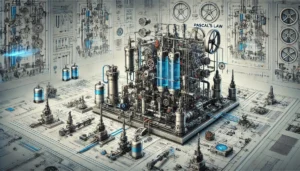This guide aims to specifically cater to the importance of practicing efficient methods when using slings and hoists so as to avoid injuries, accidents or even damaging valuable equipment. On a more positive note, effective operational methods make sure that personnel and equipment are safe while improving productivity. Most importantly, it identifies how one could best choose, operate and inspect the hoists and slings.
Understanding Hoists and Slings
Slings are defined as lifting devices that are somewhat versatile in nature in the sense that, unlike wires, chains or synthetic fibers, they can even be made out of material, plastic, or any other sort of flexible material. Hoists, on the other hand, serve the purpose of lifting or lowering loads and making use of a drum or wheel in conjunction with a rope or chain. Understanding these two terms gives us greater awareness in using both of them more efficiently. For example, a proper pair of slings and hoists are essential for safe material handling.
Selection of Appropriate Equipment
Choosing the right pair of slings and hoists for a specific job is crucial. The following are the factors that one should take into consideration when choosing the right pair:
- Load Weight and Capacity: Ensure that the hoist and sling can support the load’s weight without exceeding their rated capacities. Overloading equipment is a leading cause of failures and accidents.
- Type of Load: Examine the load’s properties, as these include dimensions, shape, and center of gravity. This comparison skirts towards selection of the appropriate sling type and rigging technique and best preserves load balance during lifting.
- Environmental Conditions: Review the working conditions like the temperature, humidity, and even chemicals that may be present which affect performance and lifespan of hoists and slings.
Pre-Use Inspection
Both hoists and slings will require inspection before their usage:
- Hoists: Pay attention to the signs of corrosion on hooks, chains, or even the hoist. Ensure that all safety latches are appropriately functional. Make sure the control mechanism moves freely with no blockages.
- Slings: Check for all forms of damages such as cuts, fraying, or broken wires. Make damage tags readable and that the rated capacity is suitable.
All equipment that are found to have defects must be marked and taken out of service until they are fixed or have new equipment issued.
Proper Rigging Practices
Prevent load movement that could cause harm using proper rigging techniques:
- Sling Configuration: Arrange slings based on vertical, choker, or basket hitches depending on specific load and lift needs.
- Load Balancing: The load must be positioned and adjusted, so as not to exceed the designated limits to avoid tipping or sliding.
- Attachment Points: Lifting slings should be used on the designated points of the load. Do not use slings on sharp edges without sufficient padding to avoid damaging the sling.
Safe Operation Procedures
Proper procedures must be followed during lifting operations:
- Use Controlled Movements: Do not jerk the hoist, use steady movements, as it can cause shock loading which places stress on the gear and may cause it to break.
- Clear Communication: Use agreed upon standard hand signals or hand held communication devices as means to coordinate movements of team members.
- Load Path: Make sure that there are no personnel under the load. Always instruct workers not to stand under or near a load that is suspended.
- Remain Prepared for Emergencies: Plan on how to deal with an emergency, determine the mechanism of lowering a load, when a malfunction takes place at the equipment.
Competency and Training
All lifting operation personnel should undergo appropriate training due to the importance of the task.
- Equipment Operational Training: Workers must know how to operate hoists and slings, comprehend the load limits, how to rig and control the operation.
- Identifying Missing Hazards: The training sessions on hazard recognition should also ensure that the employees can correct the issue at hand and the defective equipment and environment that can lead to unsafe conditions is dealt with effectively.
- Safety training updates: Employees are able to obtain information about new equipment used or newly released safety measures, hence increasing competency due to regular refresher safety training updates.
Proper Maintenance and Equipment Storage
The slings and hoists have a longer life span when properly stored and maintained:
- Scheduled Maintenance: Consistent lubrication, part replacement, and certified inspections should always be carried out per the manufacturer’s recommendations.
- Storage Conditions: The slings should not be twisted or kinked so they should be stored in a dry and clean area while the hoists should be elevated off the ground to prevent moisture damage. Above all, the working conditions have to be free from chemicals and sunlight.
Legal Compliance
The relevant industry safety requirements and regulations must be followed:
- Occupational safety and health administration: Ensure compliance with OSHA regulations on lifting equipment and its operations.
- Industry Practice: Follow guidelines from organizations such as the American Society of Mechanical Engineers (ASME) and the National Institute for Occupational Safety and Health (NIOSH) for best practices in lifting operations.
Safety procedure improvement areas can be identified while compliance is maintained through audits and inspections that are done on a regular basis.
Conclusion
Using hoists and slings in the workplace can be safe and efficient if proper practices are put in place. To ensure workplace safety and productivity, it is crucial for companies to have the right equipment, carry out systematic checks on the equipment, use the correct rigging techniques, and operational procedures, train employees, and carry out routine maintenance on the equipment. This in turn will augur well for workplace safety and productivity. The more responsible, vigilant, and proactive an organisation is, the greater the success they will achieve.










